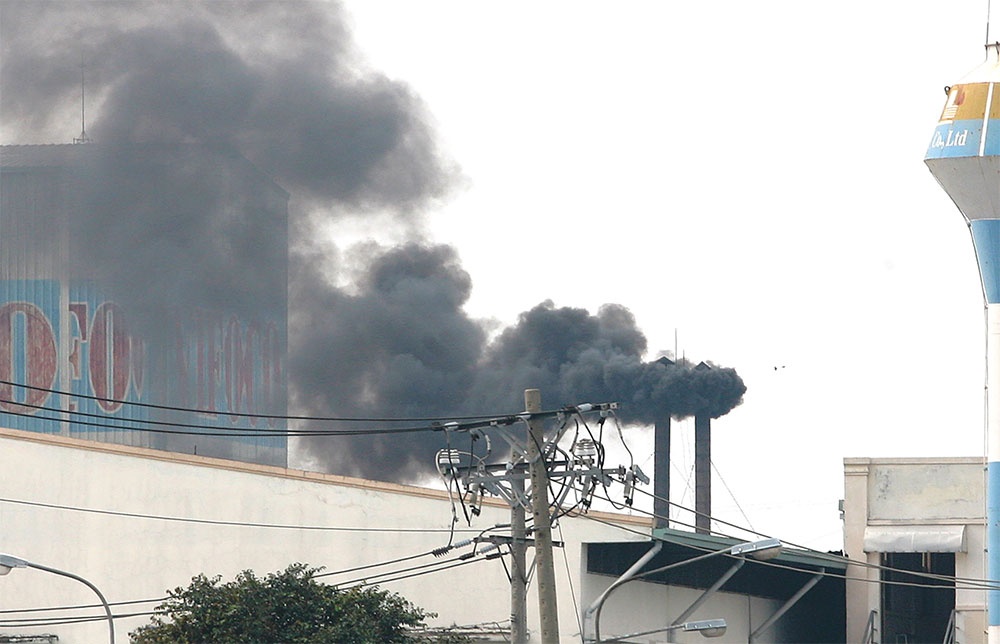Vietnam sets out to deal with carbon tax and market barriers
Vietnam is moving towards the challenging goal of becoming a high-income country by 2045 and achieving net-zero emissions by 2050. Meanwhile, the government has only indirectly taxed carbon through the environmental protection tax for enterprises producing and importing fossil fuels.
 |
| Vietnam sets out to deal with carbon tax and market barriers, illustration photo/ Le Toan |
Enterprises in the northern province of Hai Duong, which is considered a major cement production centre of Vietnam, could feel the impact of a carbon tax the most. In 2019, VICEM Hoang Thach Cement Group accounted for 4 per cent of Vietnam’s output, at about 3.8 million tonnes. The use of limestone to produce commercial concrete has helped Hoang Thach create high-quality but also cheaper product lines.
However, Hoang Thach’s production line is also deemed as one of the bigger contributors to global warming, and cement production and greenhouse gas (GHG) emissions have always increased together.
The national GHG inventory, report released in 2021 conducted by the Ministry of Natural Resources and Environment in 2016, showed that the total emissions of the whole country were 316 million tonnes of CO2 equivalent. This figure is expected to increase to 928 million tonnes of CO2e by 2030 and 1.5 billion tonnes by 2050 under the business-as-usual scenario.
According to the report, since 2000, emissions from energy activities such as transportation, industry, and residential development increased rapidly, accounting for 65 per cent of total emissions in 2016. Compared with neighbouring countries in Southeast Asia, Vietnam’s emission intensity per unit of GDP is quite high, at about 0.35 kg CO2 per USD.
Experts criticise that the tax rate does not reflect the nature of carbon pricing if calculated per unit of GHG, as the tax rate for petrol is higher than for coal. International experience could help Vietnam flexibly apply carbon tax and market measures to optimise emissions reduction. This may allow businesses to be flexible and proactive in choosing measures to comply with emission quotas, thereby bringing about cost-effectiveness in emission reduction.
In Vietnam, carbon pricing tools have been gradually developing, including the environmental protection tax, an indirect tool that has been used for a long time, and the carbon market, a direct tool that will be applied in the future. Many domestic analysts believe that Vietnam is still struggling in determining the criteria in carbon pricing instead of considering factors for this tool to be effective, including a support mechanism for those who suffer from carbon emissions.
In theory, carbon pricing is an economic policy tool aimed at achieving emission reduction targets at the lowest cost by balancing emissions reduction costs across sectors and sources of GHG emissions.
The report State and Trends of Carbon Pricing 2022 by the World Bank from April states there are 68 carbon pricing tools in use globally, with three more tools in the pipeline. Carbon pricing is covering about 23 per cent of total GHGs globally.
Truong An Ha, an analyst at the Vietnam Energy Transition Initiative, said, “Building and operating a domestic carbon market will help Vietnam seize opportunities to reduce carbon emissions efficiently.”
The carbon market could also help Vietnam increase compatibility with international carbon pricing mechanisms and create opportunities to link with regional and international carbon markets, Ha added.
“However, building and operating a carbon market is a process. Vietnam must mobilise all resources to meet financial, technical, and human resource requirements, and apply innovative solutions that can become effective and feasible tools.”
Immediately after COP27 a month ago, more and more domestic analysts wanted to discuss the carbon market. They believe that, when the market is operational, each business will have an emission quota. Enterprises would have to calculate emissions reduction by producing fewer products or by using more modern technologies to reduce emissions.
Dr. Nguyen Phuong Nam, director general of Klinova Climate Innovation JSC said, “When businesses mobilise green credits and green bonds in the carbon market, the world recognises this as a strong enterprise and ensures the possibility of cooperation and development.”
In the short term, the carbon market may have negative impacts on business performances, but in the long term, it could offer more benefits to companies, Nam added.
| - In the past three years, Vietnam has strongly developed renewable energy, especially solar and wind power, with more than 16.5GW of solar power capacity connected to the national grid, and nearly 4GW of wind power onshore and near shore, as well as 20.6GW of hydroelectricity. Renewable energy in Vietnam currently accounts for 52.2 per cent of installed capacity nationwide, according to the Ministry of Industry and Trade. - Vietnam’s contribution to GHG emissions is minimal, at only about 0.8 per cent of total global emissions. At the same time, it is one of the most vulnerable countries to climate change, ranking 13 out of 180 countries, according to Germanwatch’s Global Climate Risk Index 2000-2019. - The carbon market was first mentioned in Decision No.1775/QD-TTg in 2012, followed by Resolution No.24-NQ/TW and Resolution No.50-NQ/CP, both in 2013. In 2021, the government included the establishment of a carbon market in its mandates to respond to climate change and protect the environment. - Regulations on mitigation of GHG emissions and protection of the ozone layer have specified the roadmap for establishing a domestic carbon quota exchange system in Decree No.06/2022/ND-CP and the Law on Environmental Protection 2020. - In January, the prime minister issued Decision No.01/2022 on the list of industries, subsectors, and establishments that must carry out an inventory of GHG emissions, which includes pver 1,600 establishments in the industry and trade sector, 70 in the transport sector, over 100 in construction, and 76 in natural resources and the environment. |
 | Leveraging carbon markets for Vietnam’s climate commitments Vietnam has identified the importance of shifting away from traditional models of growth in order to sustain the development gains of recent decades. The country adopted its National Green Growth Strategy in 2021 and developed the Green Growth Action Plan the following year. In 2021, Vietnam made a commitment to bring net emissions to zero by the middle of the century. |
 | Defining the crucial role for voluntary carbon markets With 2030 not that far away, if nations and companies are to accelerate towards their net-zero targets, voluntary carbon markets have an essential part to play. |
What the stars mean:
★ Poor ★ ★ Promising ★★★ Good ★★★★ Very good ★★★★★ Exceptional
 Tag:
Tag:
Related Contents
Latest News
More News
- Heavy industries set for pilot greenhouse gas quotas (December 25, 2025 | 10:00)
- Swedfund invests in MSME growth and climate action in Vietnam (December 19, 2025 | 11:42)
- GreenYellow brings solar energy to light up remote schools in Tuyen Quang province (December 19, 2025 | 08:00)
- Charge+, Grab partner to develop EV charging network in Vietnam (December 18, 2025 | 17:11)
- Linking sci-tech and innovation to Vietnam’s net-zero future (December 18, 2025 | 14:31)
- Driving double-digit growth through green and circular transformation in Vietnam (December 17, 2025 | 09:00)
- Standard Chartered and ACCA deepen collaboration to develop Vietnam’s talent for a sustainable future (December 15, 2025 | 18:18)
- Schaeffler reports strong early output from Dong Nai solar project (December 12, 2025 | 15:16)
- Forestry conference highlights biodiversity and sustainability goals (December 09, 2025 | 13:35)
- Home Credit honoured among top 10 sustainable companies in trade and services (December 09, 2025 | 12:18)






















 Mobile Version
Mobile Version